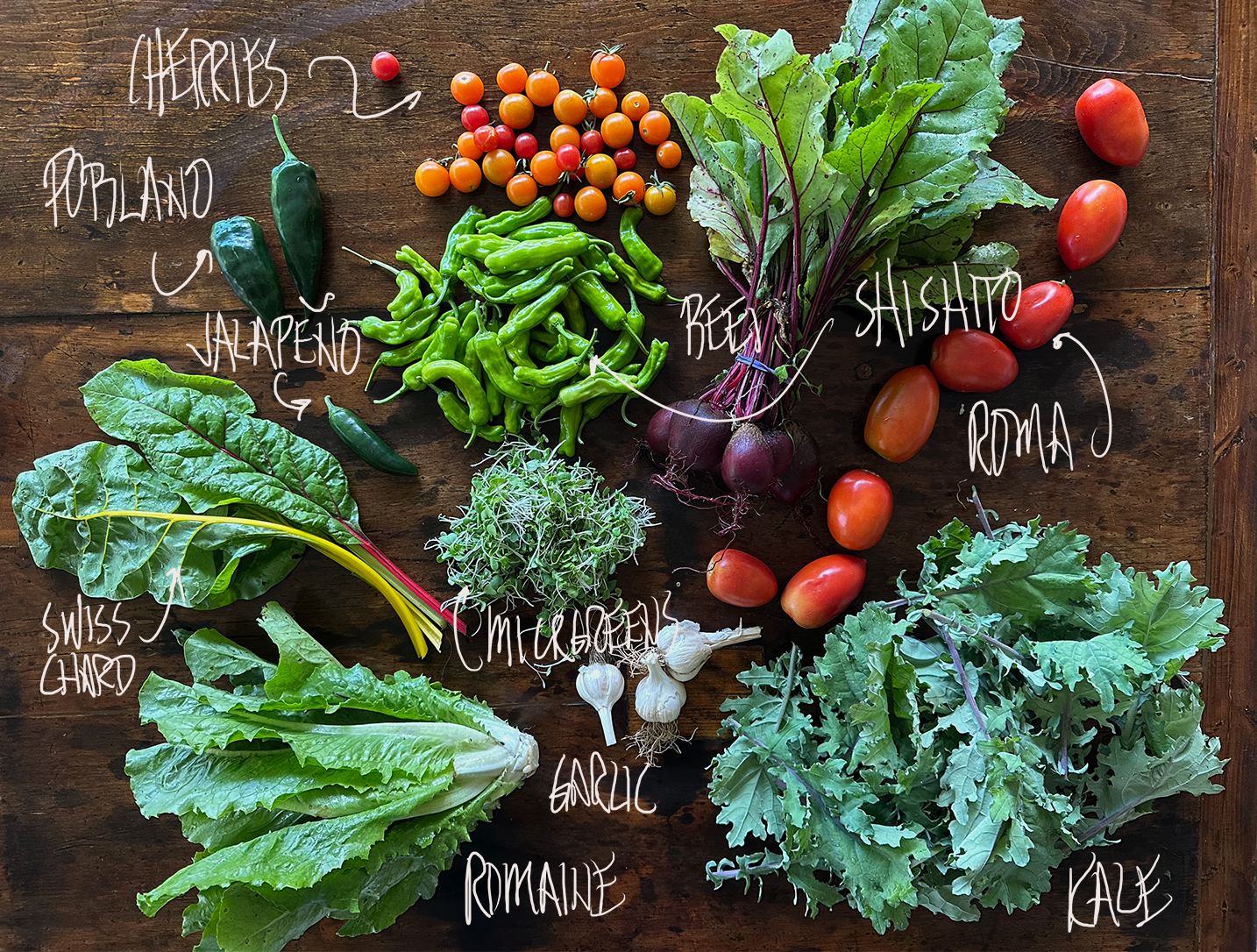2025 Season | Week 22
Shit-ton of Shishitos
It’s shishito week at YSFG, and to celebrate, Matt is sharing his sure-fire crowd-pleasing shishito appetizer recipe. Here goes…
1. Wash your peppers, then stir-fry over high heat with olive oil for a few minutes till crispy and brown
2. Deglaze with fresh lemon juice and dry white wine, remove from heat
3. Garnish with Parmesan and fresh cracked black pepper.
Well, that was easy. Give it a try and let us know what you think.
Have a great week.
Damn, look at “them” beets. We’ve found that transplanting is the way to go as we can get the spacing just right - making a better beet.
We welcome visitors to the farm, but we quickly put them to work the next morning—sometimes before they’ve even had a chance to get dressed. Here, Jarrette, in her robe and visiting from Irvington, VA, learns the finer aspects of microgreen harvesting.
-
BEETS 101—Beets are healthy, versatile, taste amazing, and look beautiful. One of the best things about them is that they keep well before and after cooking, and every part is edible and delicious. Beets can be broiled, steamed, grilled, or roasted, our favorite. (We like cut beets roasted in olive oil and salt and pepper the best!)
EAT NOW—Roots: Just before cooking, scrub the beets well and remove any scraggly leaves and rootlets. If your recipe calls for raw beets, peel them with a knife or a veggie peeler, then grate or cut them according to the recipe. To remove the skins, roast them in foil or boil them, and the peels will slip right off.
Beet greens: Wash the leaves in a basin of lukewarm water to remove grit. Remove the thicker stems. Depending on use, cut the greens into appropriately sized pieces.
OR LATER - To Freeze: Beet Roots: Boil or bake beets until done. Cool them in ice water or let them come to room temperature. Remove peels. Trim the beets into 1/4-inch slices or keep them whole (if they are small). Place in a freezer bag and remove as much air as possible. Seal and freeze. Beet greens: Blanch wash beet greens for 2-3 minutes in hot boiling water. Immediately dunk in ice water to stop the cooking process. Then drain and pack into airtight containers. Freeze them in “balls” on a cookie sheet, then pop them into a freezer bag for the perfect portion.
DON’T TOSS THOSE BEET GREENS! - Beet greens are delicious! Here are some simple ways to use them: Use them for making vegetable stock, toss them into a salad — especially the smaller leaves, braised with a bit of olive oil, garlic, and pepper flakes, toss in a smoothie, add them to an omelet, frittata, or quiche, stir them into a pasta sauce in the final stages, add to a soup, like you would kale or spinach, turn them into a pesto
RECIPES
-
Fresh Garlic 101
Fresh-harvested garlic, also known as “wet” or “green” garlic, is garlic that’s been pulled from the ground before it’s fully cured. Unlike the dry, papery bulbs you find in the store, fresh garlic has moist skins, juicy cloves, and sometimes green stalks still attached. The flavor is milder and more delicate than cured garlic, with a slightly grassy, almost sweet note—perfect for early summer cooking.Eat Now
Use fresh garlic anywhere you’d use regular garlic, but celebrate its tenderness! Slice or mince the cloves for sautés, salad dressings, or marinades. The juicy cloves melt beautifully into sauces, and the mild flavor makes it a lovely addition raw in dips or spreads. If the stalks are still soft, you can treat them like scallions—chop and toss into stir-fries, soups, or omelets.Eat Later
If you’re not using it right away, store fresh garlic in a cool, dry spot with good airflow. It won’t last as long as cured garlic—typically a few weeks—so keep an eye on it. To preserve the harvest, you can cure the garlic yourself by allowing it to dry for a few weeks, or peel and freeze the cloves for longer storage. Roasting and storing in oil (with proper safety precautions) is another delicious way to enjoy fresh garlic down the road. -
KALE 101 - Wash leaves in lukewarm water. If your greens have thick stems, remove them by folding each leaf in half and slicing out the stem. Then, stack the leaves up and slice diagonally into 1” wide strips.
EAT NOW - Wrap unwashed chard or kale in a sealed plastic bag in the crisper drawer of the fridge. Best used very fresh, but may last for a week. To freeze, blanch washed greens, rinse in cold ice water, drain, and pack into airtight containers.
OR LATER - Swiss chard or kale can both be eaten raw or cooked. A longer cooking time is best as it brings out the sweetness in the greens. Extremely high in vitamin K and vitamin A, these nutrient-dense greens can help combat cancer and reduce blood pressure! Chard and kale can be used interchangeably with: collards, turnip greens, beet greens, broccoli raab, mustard greens, dandelion, and spinach.
-
Microgreens 101—Before use, rinse gently in cool (not hot or cold) water to remove excess dirt. Pat or spin dry, and you’re good to go! Pat or spin dry your greens to remove excess moisture (moisture = mush!). Place loosely in a plastic bag or container and put in the fridge. They will keep for up to one week.
Eat These Immediately!
-
PEPPERS 101 - Whether hot or sweet, peppers are full of beneficial vitamins and minerals and are great raw or cooked. They can be sliced on pizzas or as part of salads and even stuffed with meats and cheeses. Hotter peppers like jalapeños can be cooked or roasted to reduce their heat. They make a great addition to any meal such as: sandwiches, tacos, pizzas, or chopped and added to soups, stews, sauces and more. Our personal favorite, are Jalapeño Poppers.
EAT NOW - First rinse and dry your peppers. Cut off the top and slice. If preparing hot peppers, be careful to wash your hands after handling - don’t touch your eyes! For less spicy peppers, cut in half length-wise and remove seeds and ribs. Are best stored whole.
OR LATER - Store whole or sliced in fridge for up to 1 week. To store longer, flash freeze (whole or sliced) on a cookie sheet. Transfer to a freezer bag once frozen. They keep well in the freezer – no need to thaw for use in cooked dishes.
RECIPES
-
ROMAINE 101 - Romaine lettuce belongs to the lettuce family, Asteraceae, and it is characterized by its elongated, sturdy leaves and crisp texture. It is a nutritious vegetable, rich in vitamins and minerals. Romaine lettuce is an excellent source of Vitamin A, Vitamin K, folate, and fiber.. If you’re looking for low carb options, try using the large leaves as a wrap with your favorite fillings. Or, whip together a crisp and delicious salad by mixing with other greens and your favorite fruits, nuts, or cheeses!
EAT NOW - Slice the head of your lettuce at the base with a knife and let the leaves fall open. Remove any damaged or leathery leaves, then tear remaining into bitesize pieces. Wash in a basin of cold water and spin dry.
OR LATER - Store unwashed lettuce in a plastic bag in the refrigerator. If you’ve already washed and dried it, place in a plastic bag with a dry paper towel in the bag as well and place in the vegetable crisper of your refrigerator.
RECIPES
-
SWISS CHARD 101 - A member of the Beet family, Swiss chard can be eaten raw or cooked. A longer cooking time is best as it brings out the sweetness in the green. Extremely high in vitamin K and vitamin A, this nutrient-dense green can help combat cancer and reduce blood pressure! Chard can be used interchangeably with: collards, turnip greens, beet greens, broccoli raab, mustard greens, dandelion, spinach and kale.
EAT NOW - Wash leaves in lukewarm water. If your greens have thick stems, remove them by folding each leaf in half and slicing out the stem. Then, stack the leaves up and slice diagonally into 1” wide strips.
OR LATER - Wrap unwashed chard in a sealed plastic bag in the crisper drawer of the fridge. Best used very fresh, but may last for a week. To freeze, blanch washed greens, rinse in cold ice water, drain, and pack into airtight containers.
RECIPES
-
TOMATOES 101 - Probably the most versatile fruit in the garden, tomatoes can be used in countless ways - salsa, gazpacho, sauces, slow roasted, puree and even a bloody Mary. Ours are grown for taste so eat them right out of the crate.
EAT NOW - Store unripe tomatoes upside down on a plate at room temperature until they fully ripen. Wash, pat dry, slice or dice, and enjoy the taste of a real tomato.
OR LATER - Refrigerate any fully ripe tomatoes - allow to come to room temp before serving. To freeze, first blanch and dunk in ice water to cool. Remove stems and core. Transfer to storage bags, seal and place in freezer.
To blanch, bring a pot of lightly salted water to a rolling boil. While you wait for boil, prepare an ice bath. Once boiling, drop veggies into water - water should return to boil within a minute otherwise you have too much veg for the water. Once boil has returned, cook for 1-5 min until veg has a vibrant color. Immediately put into ice bath to stop cooking.
RECIPES




